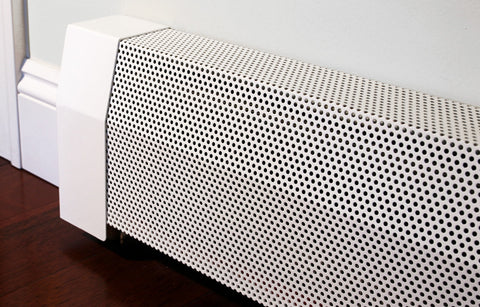How Long Will Baseboard Heater Covers Last?

When updating your home, the small details often have the biggest long-term impact. One commonly overlooked feature? Your baseboard heater covers. While both plastic and metal covers may seem similar at first glance, their real-world performance tells a very different story.
In this article, we’ll explore how each material holds up over time in terms of durability, appearance, safety, and cost-efficiency—so you can make the best choice for your space.
Longevity: Why Material Quality Matters
While aesthetics are often a key factor in your decision, what truly defines the value of a baseboard heater cover is how it performs over time. Industry professionals put forward these facts about powder-coated steel vs plastic baseboard heater covers.
Powder-Coated Steel: Engineered for Longevity
Steel baseboard covers, especially those with a powder-coated finish, are built to outlast trends and wear. They offer:
- Exceptional structural durability – Steel resists warping, cracking, and brittleness, even under regular exposure to heat.
- Superior finish retention – Powder coating protects against rust, chipping, and discoloration, maintaining a like-new appearance.
- Fire resistance – Steel is non-combustible, making it a safer choice for high-temperature environments.
- Thermal efficiency – Metal conducts heat better than plastic, helping maintain consistent room temperature.
Plastic Covers: Fast Aging, Higher Risk
Though plastic covers may be more affordable up front, they’re far more likely to show signs of wear sooner than metal:
- Discoloration and yellowing – UV exposure and radiant heat cause most plastics to degrade visually over time.
- Cracking and warping – Cheaper materials can become brittle and distort, especially in humid or cold environments.
- Melting hazard – Some plastics soften or deform at relatively low temperatures, which raises safety concerns around heating elements.
- Lower lifespan – Many homeowners report needing to replace plastic covers within just a few years.
Steel vs. Plastic Baseboard Covers: A 5-Year Comparison

Trusted by Pros, Backed by a Warranty
Professional remodelers and homeowners alike choose Baseboarders® steel covers for one simple reason: they’re made to last. Every cover is manufactured from high-grade steel and finished with a durable powder coating that resists rust, scratches, and fading.
To prove it, we back our products with a lifetime warranty against the onset of rust.
That’s long-term peace of mind you simply won’t get with plastic.
The Smart, Long-Term Choice
If you're deciding between plastic vs. metal baseboard covers, look beyond the price tag and consider the full picture. Over five years or more, steel offers unmatched durability, better heat efficiency, and a consistently polished look. The result? Fewer replacements, greater safety, and a home that always looks put together.
Frequently Asked Questions
How long do powder-coated steel baseboard heater covers last?
High-quality powder-coated steel covers like Baseboarders® can last 15 years or more with minimal upkeep.¹
Are plastic baseboard covers safe?
Not always. Plastic may melt, warp, or become brittle—especially when exposed to the constant heat from baseboard units.⁴
Is the higher cost of steel worth it?
Yes. Steel covers may cost more up front but will often save you money (and headaches) over time due to fewer replacements and better performance.
Sources
How Long Does Powder Coating Last?, Advanced Coating Technology. https://advancedcoatingtechnology.com/how-long-does-powder-coating-last.php
Polymer Degradation and Stability, Elsevier Journal. “UV and heat exposure reduce mechanical integrity of PVC products within 3–5 years.”
ASM International. Metals Handbook. “Mild steel’s melting point: ~2,500°F. Non-combustible under household heating conditions.”
Vinyl Institute. PVC Material Properties. “Softening temperature of rigid PVC ranges from 140°F–160°F.”
AAMA 2604-2605. Architectural Coating Performance Standards. Longevity guidelines for powder-coated architectural metals.

